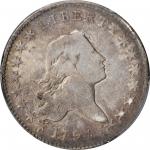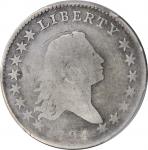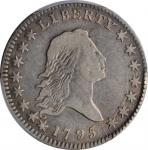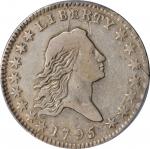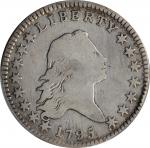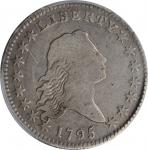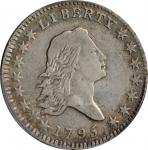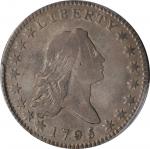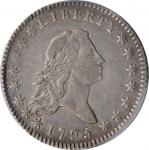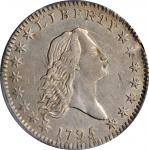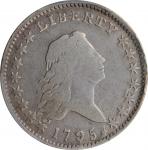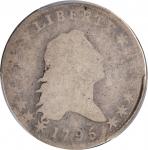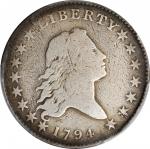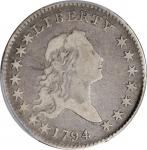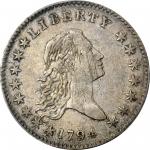1794 Flowing Hair Half Dollar. O-110, T-9. Rarity-7-. AU-53 (PCGS).
A highly significant offering for the advanced early half dollar variety collector, this 1794 O-110 is a newcomer to the census for this rare variety, and it easily claims the coveted position of CC#1. This is a lovely survivor of the United States Mint's historic first year half dollar issue irrespective of die marriage, both sides retaining ample evidence of a satin to semi-prooflike finish from the dies. The strike is nicely centered within uniformly denticulated borders, and it is equally well executed over the design elements, most of which are boldly to sharply defined in the absence of all but light wear. Softness is trivial for the type and largely confined to the high points of Liberty's portrait, stars 9 through 13, and the eagle's breast and left leg. Overall striking detail is even more impressive when we consider the presence of numerous light adjustment marks (as made) on the reverse at the eagle's breast, tail, below its left leg, and along the border from 1 to 11 o'clock (in other words, around virtually the entire periphery). With the overall sharp detail alluded to above, these adjustment marks obviously did not interfere with the strike to any great extent, which they often do. Additional provenance markers include two faint planchet drift marks on the obverse, one in the field between the base of Liberty's portrait and the date and the other, more extensive, at and near stars 11 through 15. Predominantly brilliant with bright silver dominating the in hand appearance, both sides are further enhanced by blushes of iridescent reddish-apricot and cobalt blue toning near the left borders. Pleasingly smooth for the assigned grade with only the expected number of light, wispy handling marks, this remarkable absolute and condition rarity is sure to have no difficulty finding its way into another advanced half dollar variety set.
While today the half dollar is seldom seen in circulation and offering one up in change will often generate odd looks and questions, it is only relatively recently that this has been the case. Half dollars have traditionally been "workhorse coins intended for use in the channels of commerce," as Q. David Bowers described them. The reduction in the required surety bonds for the chief coiner and the assayer so that production of precious metal coins could commence came too late in 1794 to make a huge impact on the nation's circulating coins during that year. Indeed, the first year 1794 Flowing Hair half dollar was produced to the extent of just 23,464 pieces, as opposed to a much larger delivery of 299,680 pieces for the 1795. By the latter year, which was the last in which the Mint used the Flowing Hair motif in this series, the half dollar had already established itself as the denomination of choice among contemporary bullion depositors, a situation that would continue well into the 19th century.
Numismatic scholars have identified 11 die marriages of the 1794 Flowing Hair half dollar, which range from the relatively common Overton-101 to the unique O-109 (two copper impressions are also known) and O-111. We stress the word "relatively" in the preceding sentence for the 1794 half dollar as an issue is scarce from a market availability standpoint, such is the demand for examples from both first year type collectors and early half dollar enthusiasts. In the finer circulated and Mint State grades, as here, the 1794 is rare and eagerly sought irrespective of die marriage.
Overton-110 is in the second rarity tier among 1794 half dollar die pairings. The variety is collectible, but just barely as it must still be considered extremely rare in all grades. The elusiveness of survivors is explained by the fact that very few coins were struck from this die marriage in the first place. All known examples display at least the beginning of a break that would eventually bisect that side of the coin from the border outside the first letter A in AMERICA to the opposite border outside the letter D in UNITED. The present example is a middle die state, Tompkins Die Stage 1/2, with the reverse crack fully formed, although not yet so heavy that the area of the coin above the crack has risen above the area below. This crack clearly developed early, and advanced quickly, leading Mint employees to withdraw this die from production after a limited press run. Overton-110, in fact, represents the only known use of this reverse. The obverse die, however, soldiered on and, paired with two different reverse dies, struck coins of the O-103 and O-104 varieties (in that order, per Tompkins).
This variety eluded numismatic discovery until 1982, when Jules Reiver acquired a 1794 half dollar from Werner (?) in March of that year that he subsequently confirmed as the previously unknown O-110 marriage. In the 37 years since Reiver's discovery only 11 additional examples of the 1794 O-110 variety have been confirmed.
Including the coin offered here, we are aware of just 12 examples of the 1794 O-110 half dollar. Expanded from the listing in Steve M. Tompkins' 2015 reference Early United States Half Dollars, Volume I: 1794-1807, the grades listed in our census are as of the coins' most recent auction appearance, where relevant:
1 - PCGS AU-53. Ex E. Horatio Morgan Collection. The present example, prior provenance unknown, and missing from the published census listings:
-United States Early Half Dollar Varieties: 1794-1836, Fifth Edition, First Printing, by Donald J. Parsley, published 2013. Census listed as (40, 8, 8).
-Early United States Half Dollars, Volume I: 1794-1807, by Steve M. Tompkins, published 2015. Census listing includes nine coins, ranging in grade from EF-40 to AG-3.
-Auction & Mail Bid Prices Realized for Bust Half Dollars: 1794-1839, by Stephen J. Herrman, Spring 2019 revision. "10 known," with coins listed that range in grade from VF-20 to AG-3.
2 - EF-40. Discovered in Europe, 1994; Eastern collection.
3 - PCGS VF Details--Repaired. Ex Heritage's CSNS Signature Auction of April 2016, lot 4650; Heritage's Long Beach Signature Auction of September 2016, lot 5486.
4 - NCS VF Details--Damaged. Ex Heritage's sale of the Terry Brand Estate, Part XI, August 2018 ANA sale, lot 4266.
5 - Fine-15. American Numismatic Society Collection (misattributed as O-103). Donated in 1980 by the estate of Arthur J. Fecht.
6 - Fine-12. Ex Kagin's ANA Auction of August 1977, lot 1386; our (Bowers and Merena's) James D. Brilliant and William R. Sieck Collections sale, January 1992, lot 1205.
7 - VG-10. Ex Paramount's session of Auction '86, July 1986, lot 1637; Jim McGuigan; Sheridan Downey; Overton Collection. The plate coin for the variety in both the fifth edition of the Overton/Parsley and Tompkins early half dollar references.
8 - PCGS Good-4. Ex Werner, March 1982; Jules Reiver; Heritage's sale of the Jules Reiver Collection, January 2006, lot 22479; Heritage's sale of the Westmoreland County Collection of Early Bust Halves, 1794-1807, January 2008 FUN Signature Auction, lot 2830.
9 - PCGS Good-4. Ex Colorado estate, unattributed; eBay, 2012; Charles Merrill Collection; Heritage's sale of the Merrill Collection, February 2018 Long Beach Signature Auction, lot 3850.
10 - PCGS Genuine (Good Details). Ex Heritage's FUN Signature Auction of January 2011, lot 5537; Dr. Charles Link Collection.
11 - ANACS Good Details--Plugged, Tooled, Re-Engraved. Ex our Baltimore Auction of March 2014, lot 5333.
12 - SEGS AG-3. Ex Superior's June Pre-Long Beach Sale, May-June 1999, lot 2171; Sheridan Downey's Mail Bid Sale #25, June 2000, lot 190.
As the foregoing census makes clear, the PCGS AU-53 offered here is easily the finest known example of this rare die variety. Most other examples are in far lower grades, and many are significantly impaired. With solid technical quality and outstanding visual appeal, this coin is destined to serve as a highlight in an advanced early half dollar cabinet. Outstanding!
Provenance: From the E. Horatio Morgan Collection.
PCGS# 39212. NGC ID: 24E6.
Click here for certification details from PCGS.



